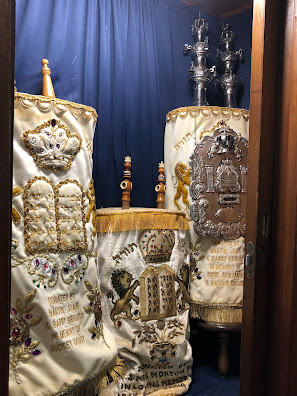Exterior Image 1
Exterior Image 2
Artifact Image 1
This is one of the many Spanish stained glass windows present in First Congregation Sons of Israel, first installed in the sanctuary in 1953. Rabbi Jacob's three daughters, Sarah Bernstein, Florence Feiden, and Lena Lichter were the ones who purchased and oversaw the installation of the windows. The windows were previously utilized in an Orthodox synagogue in Atlanta, Georgia, before being transported to St. Augustine after the synagogue was demolished. The windows were eventually restored in 2013 by Ken Hardeman, the great-grandson of the original window artist. This specific window depicts an image of the Ark of the Covenant in the top center, a sacred treasure of both Christianity and Judaism.
Artifact Image 2
This is an elaborately-draped Torah stored in the ark cabinet at the back of the sanctuary. In Jewish teachings, the Torah is used to instruct followers of the Jewish faith on how to go about their lives, as the Torah itself is believed to have been gifted to Moses by God directly on Mount Sinai. The Torah is written in Hebrew, much like many other Christian and Jewish texts, and contains the first five books of the Bible, all written by Moses, namely: Genesis, Exodus, Leviticus, Numbers, and Deuteronomy. This copy of the Torah is written on scrolls of parchment and is specifically stored in the ark cabinet for use in synagogue readings and services.
Image in Conversation 1
Image in Conversation 2
Literature in Conversation
Pablo Neruda's "Sonnet XVII" conveys some similar emotions to those commonly experienced by visitors to First Congregation during times of spiritual meditation or reflection. Neruda boldly declares, "I love you as the plant that doesn't bloom but carries the light of the flowers, hidden, within itself, and thanks to your love the tight aroma that arose from the earth lives dimly in my body." One may interpret this passage as one's way of recalling the memories of times spent with deceased relatives, or perhaps as an open communication with God and a self-assurance that belief in Him can make oneself whole. The former interpretation is supported by the lightboards of the deceased at the front of the sanctuary, while the latter is simply one of many spiritual realizations one may encounter throughout life as a devout Christian or Jew, especially in a soothing, holy place like First Congregation.
Creative Component
This is a mosaic I generated based on the Star of David chandelier on the ceiling of First Congregation Sons of Israel, made up of pictures of many different flower types. I chose flowers as the primary component as they both resemble the shape of the Star of David and have a wide variety of color, similar to the Star of David mosaic outside of the sanctuary.










No comments:
Post a Comment